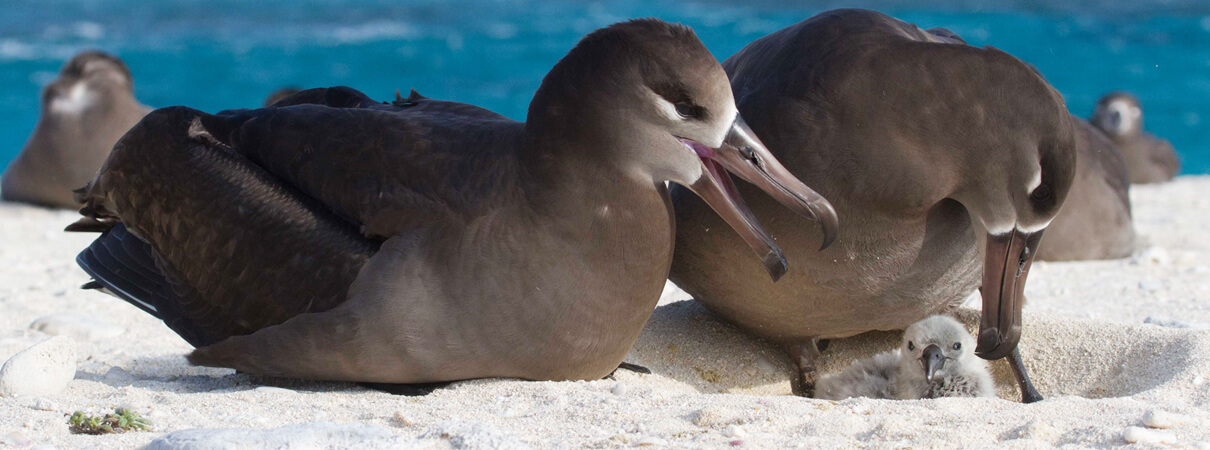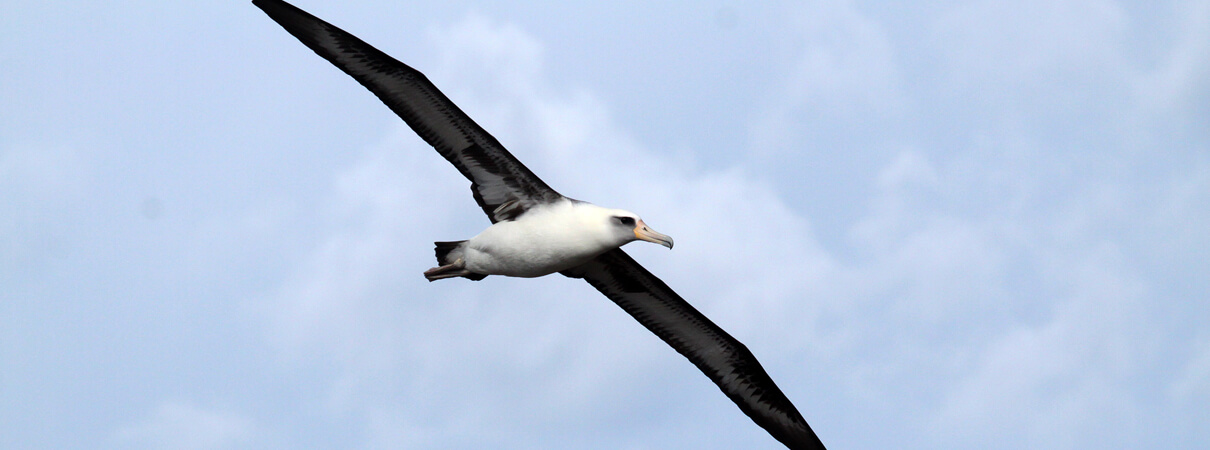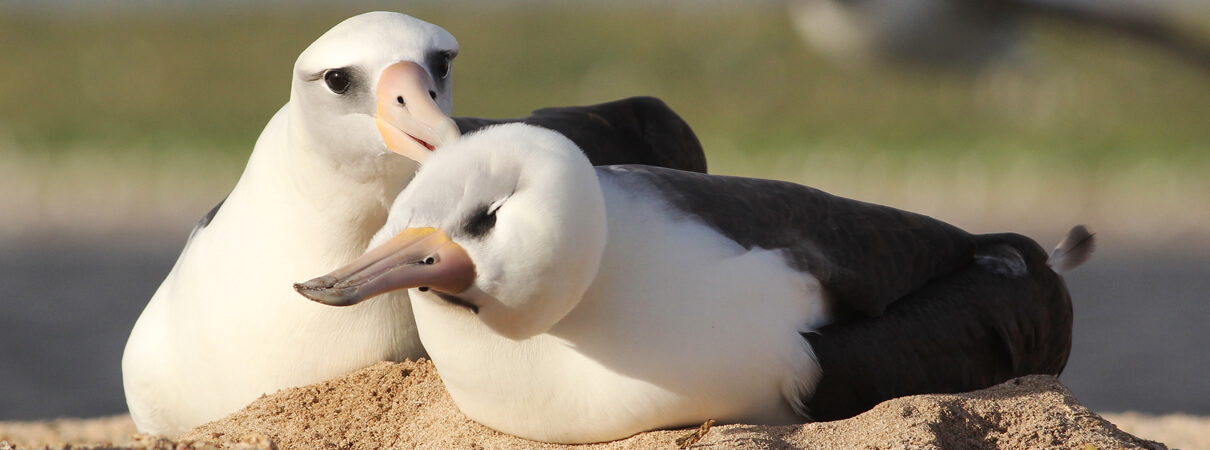New Research Suggests Need for Cautious Management of Seabirds
Like many birds, seabirds are facing major population declines as threats increase. Commercial fisheries, with their dangerous nets and lines, complicate life for the birds at sea; invasive plants and animals threaten their nesting sites on land. Scientists have been working for years to understand and manage the risks these long-lived birds face on land and at sea.
Commercial fishermen in the United States have reduced "bycatch" of seabirds accidentally caught and killed in North Pacific fisheries by using safer techniques. However, a recent study — the result of a collaborative, multi-year effort — found that nearly a decade ago, scientists had accidentally miscalculated the number of Black-footed Albatross that could be caught in fisheries without harming the species' long-term sustainability. The 2009 Status Assessment for Laysan and Black-footed Albatross eventually led to premature reductions in conservation efforts.

Black-footed Albatross and chick by Robby Kohley
Black-footed Albatross: Threats at Sea
Using a calculation called “Potential Biological Removal,” or PBR, scientists routinely provide fisheries with a yardstick to determine the sustainability of accidentally catching animals such as seabirds, sea turtles, and dolphins. The 2009 PBR for Black-footed Albatross was estimated at 11,980 birds per year, reflecting the scientists' conclusion that nearly 12,000 birds could be taken as bycatch each year without negatively affecting the species' population overall. These data were used in 2012 to support lowering the IUCN listing for the species from Endangered to Vulnerable, and from Vulnerable to Near Threatened the following year.
New analysis, conducted by Victoria Bakker of Montana State University, Myra Finkelstein of the University of California Santa Cruz, and colleagues, demonstrates that the PBR set for the species in 2009 was too high by a factor of two. It further concludes that the actual number of Black-footed Albatross caught by fisheries has exceeded the upper limit of that PBR for decades. As a result, fisheries are having a far more significant impact on Black-footed Albatross than scientists previously thought.
In light of this analysis, it's time to reassess the conservation status of the Black-footed Albatross. “I think the conservation status for Black-footed Albatross should be carefully re-evaluated based on our findings,” Finkelstein said. “We found the amount of fisheries bycatch Black-footed Albatross could sustain was about half of what was previously reported.”

Laysan Albatross by Sophie Webb
Laysan Albatross: Threats on Land
While fisheries bycatch clearly has a negative impact on Black-footed Albatross, this study shows Laysan Albatross are at greater risk from island-based threats, such as encroachment of non-native plants like Verbesina on their breeding grounds. Laysan and Black-footed Albatross both are facing an additional threat posed by non-native mice, which have been observed killing adult birds and chicks on Midway.
One silver lining from this paper, however, is that large-scale habitat restoration can help these birds' populations grow. The authors' research suggests that ongoing removal of Verbesina is resulting in population-level increases for both species.
Long-term Data for Long-lived Birds
As this study shows, confidently understanding population trends of long-lived bird species can require decades of data. To fully understand the impact of fisheries and invasive species, biologists have to go beyond the typical technique of counting the number of albatross nests. Instead, researchers must account for the fact that some albatross forgo breeding when they are in poor condition or have lost a mate.

Laysan Albatross preening by Cameron Rutt
“It's fitting that the word albatross is synonymous with ‘difficulty,'” Bakker said. “Our overarching conclusion in this research was that, given the life histories of these long-lived, slow-reproducing, and little-seen birds, it's quite difficult to understand their population dynamics without long-term data — and so they should be managed cautiously.”
The constant improvement of scientific analyses such as these will ultimately help to protect these threatened species. At ABC, we work to protect the Pacific albatross species, and we'll use this latest science to guide our efforts for these and other seabirds across the Western Hemisphere.
Learn more about ABC's efforts to help seabirds, including our website to help fisheries managers avoid bycatch.
 Hannah Nevins is ABC's Seabird Program Director. She has nearly 20 years of seabird conservation experience, ranging from the clearing of non-native rats on nesting islands to assessing impacts of gill nets. She managed the response program at the Marine Wildlife Veterinary Care and Research Center at the California Department of Fish and Wildlife, was founding board member of Oikonos Ecosystem Knowledge, and is active in the Pacific Seabird Group. Hannah received an MSc in Marine Science from Moss Landing Marine Laboratories/San Francisco State University.
Hannah Nevins is ABC's Seabird Program Director. She has nearly 20 years of seabird conservation experience, ranging from the clearing of non-native rats on nesting islands to assessing impacts of gill nets. She managed the response program at the Marine Wildlife Veterinary Care and Research Center at the California Department of Fish and Wildlife, was founding board member of Oikonos Ecosystem Knowledge, and is active in the Pacific Seabird Group. Hannah received an MSc in Marine Science from Moss Landing Marine Laboratories/San Francisco State University.


















































